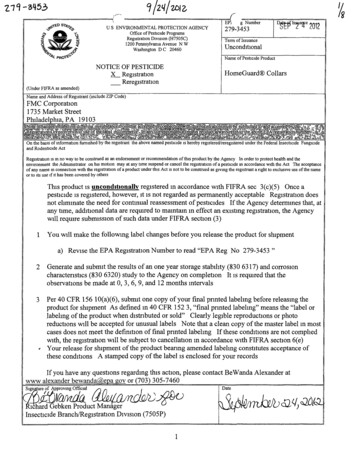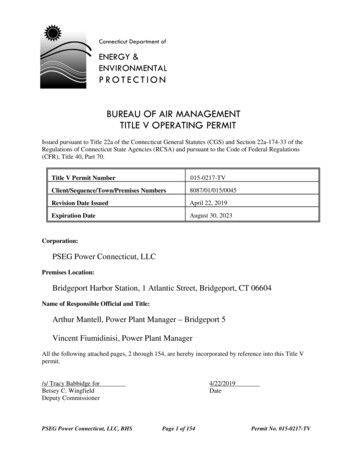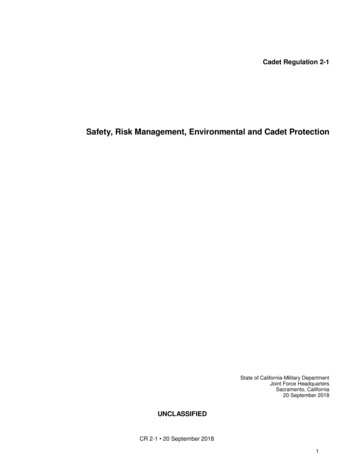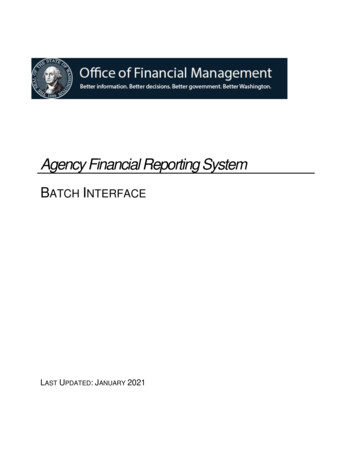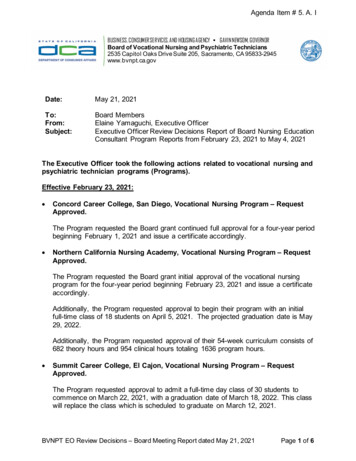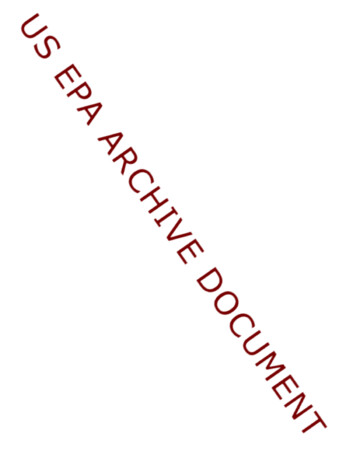
Transcription
U.S. Environmental Protection AgencyOffice of Resource Conservation and RecoveryEvaluating the Environmental Impacts of PackagingFresh Tomatoes Using Life-Cycle Thinking &Assessment:A Sustainable Materials ManagementDemonstration ProjectFINAL REPORTOctober 29, 2010EPA530-R-11-0051
Evaluating the Environmental Impacts of PackagingFresh Tomatoes Using Life-Cycle Thinking &Assessment:A Sustainable Materials ManagementDemonstration ProjectFINAL REPORTPrepared for:Office of Resource Conservation and RecoveryU.S. Environmental Protection AgencyEPA Contract No. EP-W-07-003, Work Assignment 3-682
AcknowledgmentsThe authors, Martha Stevenson, Christopher Evans, Julia Forgie, and Louise Huttinger, would liketo thank the following individuals for their contributions to this report: Greg Norris, SylvaticaCynthia Forsch, Eco-Logic StrategiesKevin Grogan & Terry Coyne, PactivHelene Roberts & Hugh Mowat,Marks & SpencerReggie Brown, Florida TomatoCommitteeChad Smith, Earthbound FarmsNiels Jungbluth, ESU ServicesBo Weidema, EcoinventCashion East, University of ArkansasPeter Arbuckle & Glenn Schaible,USDA Jon Dettling, QuantisBryan Silberman, Produce MarketingAssociationJohn Bernardo, SustainableInnovationsPeppy, Mastronardi ProduceClare Broadbent, World SteelAssociationDwight Schmidt, Fibre Box AssociationEd Klein, TetraPakGerri Walsh, Ball CorporationBionaturaeWe would also like to thank Deanna Lizas, Adam Brundage, and Nikhil Nadkarni at ICFInternational for their support on this project, and Jennifer Stephenson and Sara Hartwell at EPA’sOffice of Resource Conservation and Recovery for the input and guidance they provided for thisstudy.3
Executive SummaryThe U.S. Environmental Protection Agency (EPA)’s report, Sustainable Materials Management: theRoad Ahead, outlined a roadmap for shifting our focus from waste management to life cyclematerials management. Materials management is “an approach to serving human needs by usingor reusing resources most productively and sustainably throughout their life cycles” (EPA, 2009).To promote the management of materials and products on a life-cycle basis, the report suggestedthat EPA “select a few materials/products for an integrated life-cycle approach, and launchdemonstration projects.” This demonstration project, conducted for the Office of ResourceConservation and Recovery (ORCR), evaluates both the direct environmental impacts of packagingoptions for fresh tomatoes, and the impact of tomato packaging decisions on the life-cycleenvironmental impacts of the packaged product. We use packaging to deliver a product, so whyare the two analyzed separately from one another?The goal is to demonstrate how life cycle thinking can be used as a tool to promote sustainablematerials management. It considers three packaging options for fresh tomatoes:1. “Loose”, or minimally-packaged tomatoes that are transported in a corrugated containerbox with a General Purpose Polystyrene (GPPS) liner. Four tomatoes (2lbs) are purchasedat a time by the consumer in a Polyethylene (PE) produce bag;2. “PS Tray”, where four tomatoes (2 lbs) are packaged in an Expanded Polystyrene (EPS) tray,wrapped in a Polyethylene (PE) film, and transported in bulk in corrugated container boxes;and3. “PET Clamshell”, where four (2 lbs) tomatoes are packaged in a Polyethylene Terephthalate(PET) clamshell container and transported in bulk within a corrugated container.This report quantifies the environmental impacts associated with three different packagingoptions for fresh tomatoes, but also assesses the effect of different packaging options on the lifecycle impacts of growing, transporting, and retailing fresh tomatoes to consumers.While this project uses the tools and approaches of LCA, it is not an ISO-compliant LCA and shouldnot be used to support any claims or make any definitive choices with regards to packaging orproduct design. It is intended as a thought piece to expand both understanding of packaging andits relationship to the product and current biases toward considering climate change as the onlyimpact category.This report demonstrates how LCA can be used to answer two key questions posed by the Vision2020 report:4
1. What are the significant environmental impacts associated with thismaterial or product?By collecting data on the growing, packaging, storage and retail, and transportation of 100 poundsof fresh tomatoes, we developed a preliminary life-cycle inventory (LCI) of inputs and outputs ofthe system to assess the global warming, acidification, respiratory effects, and smog formationenvironmental impacts (Exhibit ES 1).Exhibit ES 1: Environmental impacts, by life-cycle stage, of three packaging options for producingand delivering 100 pounds of fresh tomatoes from San Joaquin Valley, California, to .734.500.733.616.196.196.19PET ClamshellGrowing20.36PackagingPS TrayStorage & RetailH moles eq. / 100 lbs. of tomatoeskgCO2e / 100 lbs. of 2.28210PET ClamshellGrowingPackaging(a) global warmingPS TrayLooseStorage & RetailTransport(b) 4E-030.0101.1E-020.0051.1E-021.1E-020.000kg NOx eq. / 100 lbs. of tomatoeskg PM2.5 eq. / 100 lbs. of 021.7E-021.7E-021.7E-02PET ClamshellPS TrayLoose0.060.040.020.00PET ClamshellGrowingPackagingPS TrayStorage & Retail(c) respiratory effectsLooseTransportGrowingPackagingStorage & RetailTransport(d) smog5
We found that: Although the difference is modest across all three packaging scenarios, the PET clamshellscenario is the most environmentally-intensive, primarily because it requires a greateramount of plastic material and because PET manufacture uses more energy per poundthan the other two plastics (PE and PS). The contribution of transportation to global warming, acidification, respiratory effects, andsmog impacts are sizable, and may dominate the impacts from other life-cycle stages atlonger distances. A sensitivity analysis confirmed that the magnitude of transportation’senvironmental impacts across these categories varies greatly, depending on totaltransportation distance. The impacts associated with producing and transporting packaging for tomatoes aresurprisingly large relative to the impacts associated with growing tomatoes, especiallyconsidering the relatively small amount of material required to package tomatoes.We evaluated the amount of water consumed by growing, packaging, storing and retailing, andtransporting tomatoes. Since it may not be obvious, please note that the water used in transport isassociated with the production of diesel for the truck. The results (Exhibit ES 2) show that: Irrigation of tomatoes during the growing phase dominates all three of the scenarios,although manufacturing packaging isExhibit ES 2: Water consumption, by life-cyclestill a significant source of water use.stage, of three packaging options for freshtomatoes delivered to Chicago, Illinois This water use is associated with the Growing, packaging, and transportingone pound of tomatoes to thesupermarket requires between 700 to850 pounds (80-100 gallons) of water.900Water consumption(lbs. water per lb. of tomatoes)manufacturing processes of thecorrugated box and the generation ofhydroelectricity used as part of theelectrical grid 88PETClamshellPS TrayLooseTransportStorage & RetailPackagingGrowing10006
GHG emissions(kgCO2e / 100 lbs of fresh tomatoes)Finally, we demonstrated how LCA can be used Exhibit ES 3: Comparison of the effect ofto investigate the effect of packaging choices on packaging and tomato spoilage on GHGthe life-cycle impacts of growing, transporting, emissionsand storing and retailing tomatoes. Based on5043.7estimates of how packaging reduced fresh4541.340.6tomato spoilage rates, we showed how4035different packaging options could either30increase or reduce life-cycle GHG emissions25relative to loose-packed fresh tomatoes,20depending on the emissions associated with15producing the packaging, and the effect that10packaging has on reducing spoilage before the50tomatoes are sold to consumers (Exhibit ES 3).Loose PackedPET ClamshellPS TrayIn a case where both PET clamshell and PS traypackaging reduce the spoilage of tomatoes at retail, the GHG emissions from manufacturing PETclamshell slightly increased overall GHG emissions relative to loose-packed tomatoes, while PS traypackaging slightly reduced total emissions by reducing spoilage.2. If all impacts are not being addressed, what more can be done?This demonstration project established a framework that can be improved and extended by EPAto: Gather further data on other impact categories, including eutrophication, carcinogens,non-carcinogens, ozone depletion, ecotoxicity, land use, and social considerations; Support efforts to improve LCA methodologies or other life-cycle tools that evaluate hardto-quantify aspects of water and land use environmental impacts, and social impacts; Include other packaging options, such as processed tomato packaging in steel cans, glassjars, or aseptic (pouch or carton) containers; Extending the analysis to include other vegetables. For example, assessing carrots (arelatively hardy vegetable with a longer shelf life than tomatoes) or spinach (a vegetablewith a short shelf life and number of fresh and processed packaging options, similar totomatoes) alongside the tomato analysis. Other kinds of tomatoes, such as greenhousegrown tomatoes could also be included. Evaluating other packaging-product systems outside of produce from an integrated lifecycle perspective.7
Since this demonstration project did not involve a full, ISO-compliant LCA of fresh tomatoes, it issubject to several caveats and limitations that would need to be addressed before making anyclaims or definitive choices with regards to packaging or fresh tomato production: Impacts associated with growing tomato transplants were not included due to datalimitations Impacts associated with ethylene spray were not included due to data limitations. Losses of tomatoes at the farm were not included due to data imitations. Although Kantoret al. (1997) found evidence of losses in the growing and harvesting process, they were notable to quantify the extent of these losses. Scenarios where tomatoes are repacked after harvest and before wholesale were notincluded, even though it is understood as a standard practice. This decision was made tolimit the number of permutations of the study. Eutrophication, human toxicity and ecotoxicity impacts were not included as we were notable to locate data on air and water emission from tomato growing process, other thanthose associated with combustion of fuels used to run equipment. U.S. data sources were used where possible but also the majority of the background datarepresented the European context, primarily from ecoinvent to fill data gaps. Environmental impacts associated with infrastructure or equipment were not included.Overall, this demonstration project contributes to a shift toward sustainable materialsmanagement by:1. Evaluating the environmental impacts associated with different packaging options from anintegrated perspective of food production, packaging, and delivery.2. Assessing environmental impacts from a life-cycle perspective.3. Extending the analysis to a number of different environmental impact categories thatprovide information relevant to EPA efforts to reduce GHGs, reduce air pollution, conservewater, and reduce material use.4. Applying LCA tools and thinking to characterize the material inputs and processes specificto the life-cycle of fresh tomatoes, and the environmental impacts of these activities,including both quantitative and qualitative discussions.8
5. Developing approaches for collecting and compiling LCI data from existing USDA databases.By applying the tools of LCA to evaluate the impacts of packaging options for tomatoes, this studyillustrates the advantages of an LCA approach in evaluating a full range of environmental impactsthat can inform multiple EPA programs and priorities. It also demonstrates how LCA can be used toassess trade-offs in environmental impacts along the life-cycle of materials and products, and toidentify hot spots and areas for further investigation. This report also identifies weaknesses in theLCA tools and considers a full range of environmental issues that may not be supported by LCAtools, but are valid considerations nonetheless.9
Table of ContentsAcknowledgments . 3Executive Summary . 412Introduction. 131.1Sustainable Materials Management: Vision 2020 Report. 131.2Impacts of Packaging Materials in the Vision Report . 141.3Designing the Packaging Demonstration Project . 15Methodology and Project Description . 162.1Goal of Study & Intended Application . 162.2Methodology and Functional Unit. 16Methodology . 16Functional Unit Definitions . 17Life-cycle Boundary Diagram. 202.3Fresh Tomato Process Description & Data Development . 21Process Description . 21Life-cycle Inventory Data Development . 222.4Packaging Manufacture Descriptions and Data Selection. 23Corrugated. 23Polystyrene Lining and Tray . 25Polyethylene Bag and Overwrap . 25PET Clamshell . 262.5Transportation Description and Data Selection . 262.6End of Life . 2710
2.7Life-Cycle Impact Assessment Methodology: TRACI 3.01 . 28Global Warming. 29Acidification . 29Human Health – Criteria Air Pollutants (i.e., Respiratory Effects) . 29Smog Formation . 302.8Life-Cycle Impact Assessment Methodology: Water . 302.9Data Quality Assessment . 302.103Caveats and Limitations to the Model . 31Quantitative Results & Discussion . 333.1Results from TRACI . 333.2Results for Water Consumption . 393.3Sensitivity Analyses. 40Impact of Packaging on Spoilage and Shelf Life . 40Transportation . 434Qualitative Discussion . 464.1Water Use . 464.2Land Use . 464.3Other Environmental Impacts . 474.4Other Human and Social Impacts . 484.5Study in Context . 505Conclusions. 526References . 57Appendix A: Additional Analyses. 6211
Processed Tomatoes . 62Processed Tomato Descriptions . 62BPA Migration . 66Other Vegetables. 66Appendix A References . 6912
1 Introduction1.1 Sustainable Materials Management: Vision 2020 ReportIn June 2009, the U.S. Environmental Protection Agency (EPA) released the report, SustainableMaterials Management: the Road Ahead (aka The 2020 Vision). It outlined a roadmap for shiftingour focus from waste management to improved materials management, which involvesunderstanding and reducing life-cycle impacts, using less material, reducing use of toxic chemicals,using more renewable materials, considering the substitution of services for products, andrecovering more materials. This shift will impact the way that our economy uses and managesmaterials and products.EP
Marks & Spencer Innovations Reggie Brown, Florida Tomato Committee Chad Smith, Earthbound Farms Niels Jungbluth, ESU Services . Office of Resource Conservation and Recovery for the input and g
